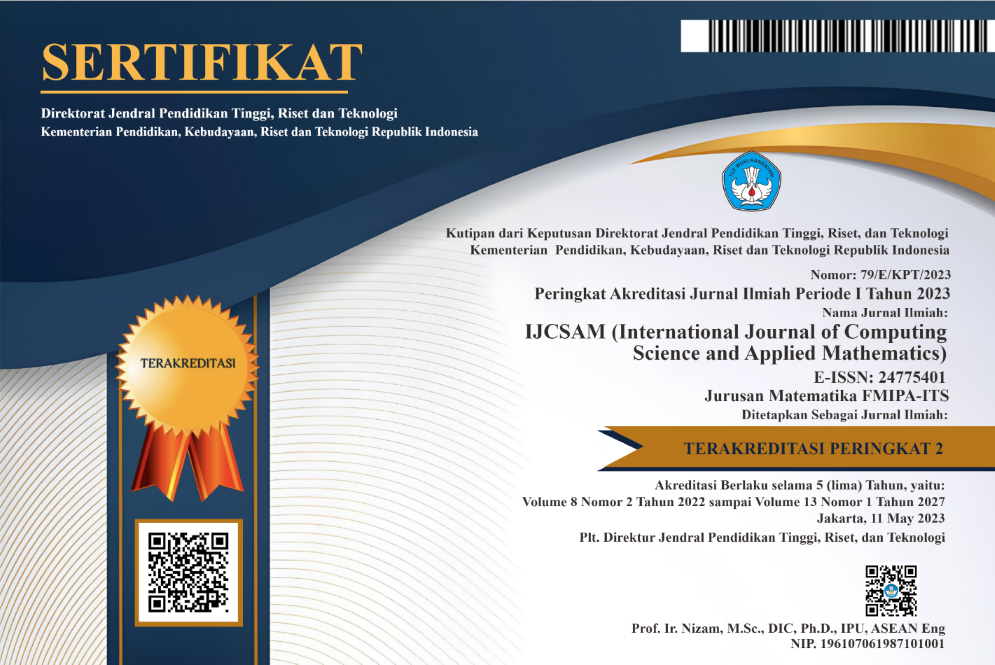The Construction of Mathematical Model for the Mechanism of Protein Synthesis Involving mTORC1 from the AMPK Pathway
Abstract
Keywords
Full Text:
PDFReferences
M. D. Cordero and B. Viollet, “Amp-activated protein kinase,” in Experientia. Supplementum, 2016.
F. A. Ross, C. MacKintosh, and D. G. Hardie, “Amp-activated protein kinase: a cellular energy sensor that comes in 12 flavours,” The FEBS journal, vol. 283, no. 16, pp. 2987–3001, 2016.
R. G. Kurumbail and M. F. Calabrese, “Structure and regulation of ampk,” AMP-activated Protein Kinase, pp. 3–22, 2016.
C. Demetriades, M. Plescher, and A. A. Teleman, “Lysosomal recruitment of tsc2 is a universal response to cellular stress,” Nature communications, vol. 7, no. 1, p. 10662, 2016.
M. Plescher, A. A. Teleman, and C. Demetriades, “Tsc2 mediates hyperosmotic stress-induced inactivation of mtorc1,” Scientific reports, vol. 5, no. 1, pp. 1–12, 2015.
J. Avruch, X. Long, Y. Lin, S. Ortiz-Vega, J. Rapley, A. Papageorgiou, N. Oshiro, and U. Kikkawa, “Activation of mtorc1 in two steps: Rhebgtp activation of catalytic function and increased binding of substrates to raptor1,” Biochemical Society Transactions, vol. 37, no. 1, pp. 223–226, 2009.
N. Dey, P. De, B. Leyland-Jones et al., PI3K-mTOR in cancer and cancer therapy. Springer, 2016.
N. Parmar and F. Tamanoi, “Rheb g-proteins and the activation of mtorc1,” in The Enzymes. Elsevier, 2010, vol. 27, pp. 39–56.
K. Maiese, Molecules to medicine with mTOR: translating critical pathways into novel therapeutic strategies. Academic Press, 2016.
S. J. Mahoney, S. Narayan, L. Molz, L. A. Berstler, S. A. Kang, G. P. Vlasuk, and E. Saiah, “A small molecule inhibitor of rheb selectively targets mtorc1 signaling,” Nature communications, vol. 9, no. 1, p. 548, 2018.
W. Chen, Y. Pan, S. Wang, Y. Liu, G. Chen, L. Zhou, W. Ni, A. Wang, and Y. Lu, “Cryptotanshinone activates ampk-tsc2 axis leading to inhibition of mtorc1 signaling in cancer cells,” BMC cancer, vol. 17, pp. 1–11, 2017.
D. A. Hall, “Enzymes and survival,” Mechanisms of Ageing and Development, vol. 28, no. 2-3, pp. 219–228, 1984.
D. Lv, L. Guo, T. Zhang, and L. Huang, “Pras40 signaling in tumor,” Oncotarget, vol. 8, no. 40, p. 69076, 2017.
Q.-b. Xie, Y. Liang, M. Yang, Y. Yang, X.-m. Cen, and G. Yin, “Deptormtor signaling is critical for lipid metabolism and inflammation homeostasis of lymphocytes in human pbmc culture,” Journal of Immunology Research, vol. 2017, 2017.
M. Rosner and M. Hengstschl¨ager, “Nucleocytoplasmic localization of p70 s6k1, but not of its isoforms p85 and p31, is regulated by tsc2/mtor,” Oncogene, vol. 30, no. 44, pp. 4509–4522, 2011.
A. R. Ahmed, R. J. Owens, C. D. Stubbs, A. W. Parker, R. Hitchman, R. B. Yadav, M. Dumoux, C. Hawes, and S. W. Botchway, “Direct imaging of the recruitment and phosphorylation of s6k1 in the mtorc1 pathway in living cells,” Scientific Reports, vol. 9, no. 1, pp. 1–14, 2019.
DOI: http://dx.doi.org/10.12962%2Fj24775401.v9i1.14351
Refbacks
- There are currently no refbacks.
View My Stats

International Journal of Computing Science and Applied Mathematics by Pusat Publikasi Ilmiah LPPM, Institut Teknologi Sepuluh Nopember is licensed under a Creative Commons Attribution-ShareAlike 4.0 International License.
Based on a work at https://iptek.its.ac.id/index.php/ijcsam.






